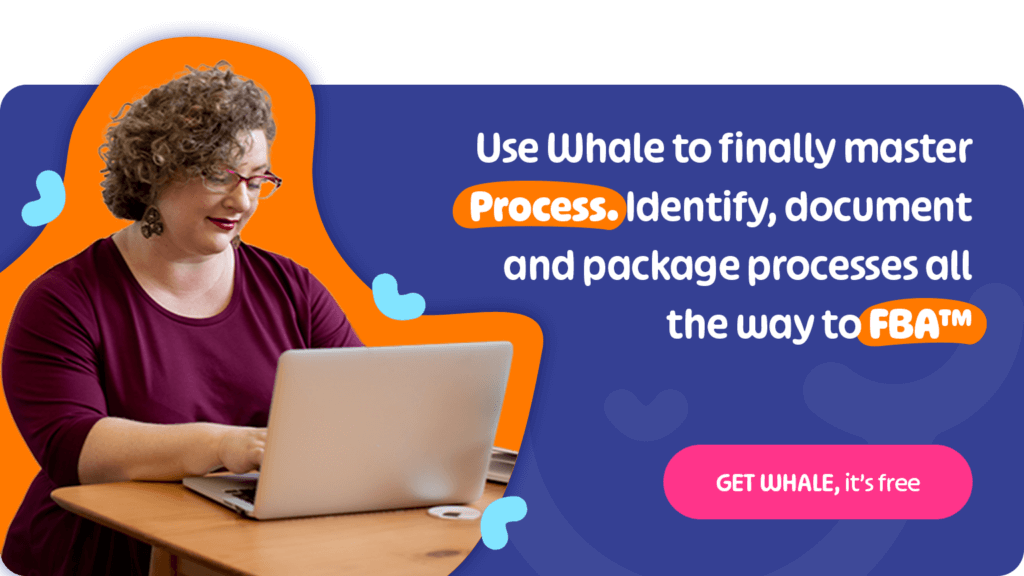Rob Liddiard shared his recent interview with Integrator and Operations Director, Meg Payne on the First-time Founders Podcast.
What to Expect When Acquiring a Startup: The Complete Picture
When you acquire a startup, you’re not just buying a business—you’re integrating its processes, people, and potential. Here’s the full picture of what to expect when acquiring a company and key steps to ensure a smooth, successful transition.
How to Build a Strong Foundation to Successfully Acquire a Startup
Building a strong foundation for startup acquisition begins with one crucial element: process documentation. To implement SOPs in startups effectively, establishing clear, concise, and impactful processes ensures operational consistency, empowers teams, and makes a startup an attractive acquisition target. Tools like Whale make this journey easier, helping you focus on what truly matters: scalable and efficient systems.
EOS® Process Component™ Matters for Startups
Most founders yawn at the first mention of “process”—I certainly did at the outset of my entrepreneurial career. However, my last startup, Yapster (a startup acquired in late 2022), wouldn’t have survived or achieved acquisition had our Integrator and Operations Director, Meg Payne, not ensured that our core processes were documented and consistently followed.
Meg recently joined me on my First-time Founders Podcast to discuss why the EOS Process Component is crucial when looking to acquire a startup or prepare one for acquisition. We explored how these structured processes helped Yapster become an attractive acquisition target, ultimately contributing to a successful transition when the company was acquired.
Core Processes: Lessons from Yapster’s Acquisition Journey
Long before any talk of acquiring a company , Meg had already defined and refined Yapster’s core business processes relating to each step of our customer journey, such as sales & marketing, customer operations, product, people and operations itself. Each process was well documented and allowed us to deliver consistent and competent customer service – and prevented us from going off track.
Our documented business processes weren’t just dormant how-to’s tucked away in a forgotten Gdrive folder; they brought clarity to roles and created a platform for professional development. Many times we were able to delegate tasks and responsibilities from my Cofounder CEO seat all the way down to graduate-level colleagues via robust process management.
For example, our Operations Executive managed multiple new customer launches and supported the full journey, from upselling to renewals. Initially, our lack of clear processes led to overhiring in Account Management—a mistake we corrected using the EOS Process Component.
Meg emphasized a key approach: “You don’t need to document every detail; focus on the essentials.” By following EOS’s 80/20 rule, we prioritized the steps that would deliver the most impact without overwhelming our team. This strategic process documentation ultimately made Yapster a more attractive and valuable target for startup acquisition.
The 80/20 Rule: Process Documentation that Powers Startup Success
When you’re working to acquire a startup or strengthen your own, time is your most valuable resource. The 80/20 rule highlights that 80% of your results come from just 20% of your efforts. For any process startup journey, this means prioritizing only the essential steps in your documentation to drive the biggest impact.
This principle encourages organisations to identify and prioritise documenting the 20% of key steps in processes that deliver 80% of the desired output. By honing in on these vital processes, your organisation can streamline operations, increase efficiency, and maximise overall effectiveness.
This targeted approach enables leadership teams to allocate resources strategically and address core elements that drive success, ensuring that efforts are concentrated where they can make the most substantial difference in achieving an organisation’s objectives.
Confessions of a Visionary: Real Insights for Startup Acquisition

This was an occasional source of (friendly) tension between me and Meg, as we strained to identify whether negative customer outcomes were the result of a process being broken, or simply not being followed—a common challenge when trying to acquire a startup or maintain efficiency within one.
After discussing in our regular Same Page meetings, 9 times out of 10 we’d conclude that the process wasn’t broken, it just wasn’t being followed – usually by me!!
Examples included when I would answer customer queries from my iPhone, rather than waiting to allow our operations executives to, or when I would seek to influence our product team to complete technical tasks ASAP rather than during allocated time windows. This would then impact on another product task needing to be completed. Looking back, I realise it was ridiculous to be actively undermining the supporting resource that I’d so longed for in our early days.
Although Meg led us operationally with great discipline, I’m proud that we also created a culture of proactive issue-solving in Yapster, which protected us against the potential tyranny of bad processes. For example, our standard 1:1s process included a key step for candid feedback on processes themselves; whether they were being followed, whether they were successfully addressing customer needs.
How Processes Helped Yapster Get Their Startup Acquired
Meg played a crucial role in documenting and establishing key processes that became critical once we began discussions to acquire the startup. These documented processes, especially around financial due diligence, were essential for smooth knowledge transfer and effective management between Yapster and our acquirer. This structure not only built buyer confidence but also reduced perceived risk, enhancing our startup’s value and lowering the chances of the buyer getting ‘cold feet.’
Improving our financial processes quickly was challenging. Early on in interactions with potential acquirers, we recognized that many of our leadership team members had been ‘abdicating’ rather than properly delegating the understanding and management of company finances to our Finance Director and external accountants.
We lacked a deep enough understanding of how resources moved through our company, which limited our ability to communicate effectively about our financial management. To address this, we introduced a monthly management accounts review as a regular item in our Level 10 meetings.
This simple addition to Yapster’s financial processes empowered our Leadership Team to discuss Yapster’s P&L, Balance Sheet, and Liabilities confidently, and to answer any questions during the startup acquisition process. I became a more financially literate Visionary, gaining the extra confidence needed to represent our business acquired with pride.
Benefits of Documenting Your Processes Before Acquiring a Startup
During our podcast, Meg and I reflected on how process management and documentation made our post-acquisition transition seamless. By documenting knowledge across all functions—marketing, sales, customer support, product, and operations—we empowered our acquirer to deliver the same level of customer service our clients expected, even in our absence.
Meg also highlighted a broader benefit: creating a company that runs smoothly without relying on founders or key team members. Her secret? Building a “vacation-ready” company culture. Clear processes allow everyone, including the CTO, to take real breaks without worrying about disruptions. It’s the key to scalability and long-term success.
Key benefits
- Seamless Transition Post-Acquisition: Well-documented processes make it easier for your acquirer to take over operations smoothly, a critical step when acquiring a company. Knowledge transfer across all functions (marketing, sales, customer support, product, and operations) allows the acquirer to maintain the same level of service your customers expect.
- Consistent Customer Experience: Process documentation ensures that your startup acquired will continue delivering a consistent customer experience, building buyer confidence and helping reduce perceived risks.
- Preparedness Beyond Acquisition: Beyond preparing to acquire a startup, strong process documentation enables a company to operate efficiently without relying on specific individuals. This makes it easier for founders and key team members to take necessary breaks without disrupting operations.
- Vacation-Ready Company Culture: Meg’s approach to process documentation fosters a “vacation-ready” culture. By establishing clear processes from the start, your team won’t need to worry about disruptions during absences—essential for a balanced, scalable process startup.
- Empowered Key Roles: Key team members like your CTO can enjoy real time off without constantly being on call, thanks to detailed process documentation. When you’re acquiring a company, this flexibility is invaluable for long-term success.
Bottom Line: Process Documentation is Your Secret Weapon for Acquiring a Startup Successfully
Establishing clear, streamlined processes is essential to prepare a process startup for acquisition. When potential buyers look to acquire a startup, they dig deep into its inner workings. A solid process framework not only boosts operational efficiency but also conveys reliability and scalability—qualities that make a startup more appealing to acquirers.
Structured processes help create valuable intellectual property, well-documented procedures, and a coherent business model. This level of organization demonstrates your startup’s ability to deliver consistent results, adapt to change, and minimize risks. For any company looking to acquire a company and integrate it seamlessly, these attributes are critical.
Ultimately, well-documented processes act as a roadmap for growth, positioning your startup for scalability. This foundation is key for acquirers seeking to expand their market reach or diversify their portfolio. A disciplined approach to process not only drives your startup’s success but also boosts its value, facilitating a smoother transition and enhancing the chances of a successful acquisition.
Get documenting & training NOW
FAQs about Startup Adquired
How do startups get acquired?
When a startup is acquired, it means a new owner—often a larger, established company—is taking over. This can happen through a cash deal, stock exchange, or a mix of both. While smaller startups might be more agile, the acquisition process itself is similar to that of a more established business. From due diligence to final agreements, the path to a successful sale requires clear processes and solid preparation.
What happens when a company is acquired?
When a company is acquired, the buyer typically pays an agreed-upon amount for all the startup’s shares and assets. For employees holding equity, this often means their stock options or shares are converted into cash or shares of the acquiring company, depending on the terms. It’s a structured process that transitions ownership while offering returns to stakeholders.
Can you sell a startup?
Yes, you can sell a startup, but it involves a comprehensive process. You’ll need to prepare various documents, such as financial records, legal agreements, and a pitch deck (reason why it’s important to have SOPs in a startup) . Finding the right buyer, negotiating terms, and completing due diligence are key steps in the process. Once everything is in place, the deal can be finalized, transferring ownership of the business.




